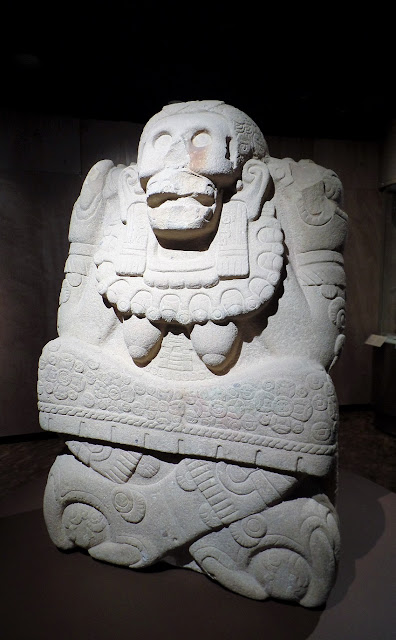The recently discovered pre-Hispanic statue which was the topic of my last post is one of the objects on display in a special exhibit at the National Museum of Anthropology called "La Grandeza de Mexico" (The Greatness of Mexico).
The exhibit contains an eclectic collection of more than 1,500 objects ranging from ancient pre-Hispanic pieces to twentieth century paintings. What I did not realize is that the exhibit is split between two locations... the Anthropology Museum as well as the Secretariat of Education in the Historic Center. My time in Mexico is drawing to a close, but fortunately the exhibit will run until next March, so I will be able to see the other half on my next trip.
The exhibit is not arranged chronologically but by theme, so at times it seemed a bit disjointed. However, it is full of interesting objects.
Here are a few of the items in the show...
Vase from the Teotihuacán culture (A.D. 400-700)
from the Popoloca culture of the region of Tehuacán, Puebla
(14th century)
by José María Velasco, 1900
by Geraldo Murillo (better known by his pseudonym of "Dr. Atl"), 1933
This banner with the Virgin of Guadlupe, may be the actual banner carried by Miguel Hidalgo in 1810 as he led his troops in the War for Independence.
of the Zapotec culture of Oaxaca (A.D. 200 - 900)
from the town of Metepec in the State of Mexico
The "Trees of Life" today represent a wide variety of themes, but this one is follows the original theme... depicting Adam and Eve in the Garden of Eden.
This book, written by Friar Bartolomé de las Casa (often referred to as "The Protector of the Indians") exposed the atrocities committed by the Spanish upon the native population.
This anonymous 18th century picture is made out of birds' feathers, a technique which goes back to pre-Hispanic times.
This anonymous 18th century painting shows the Indian Juan Diego. Supposedly the Virgin of Guadalupe appeared to him and told him to take roses to the Archbishop of Mexico. He gathered the flowers in his cloak, and when he presented them to the Archbishop, the image of the Virgen was miraculously imprinted upon his cloak.
Veracruz state (A.D. 200-900)
a 19th century painting by Eduardo Pingret
by Pelegrín Clavé (1850)
(the priest who began Mexico's War of Independence from Spain in 1810)
by Jesús Helguera (1969)
Notice the banner with the Virgin of Guadalupe which appears earlier in this post.
19th century portrait by an anonymous artist
Morelos was another hero of Mexico's War of Independence from Spain.
by Saturnino Herrán (1910)
(2500 - 100 B.C.)
by David Siqueiros (1946)
Cuauhtémoc was the last of the Aztec emperors.
Siqueiros was one of Mexico's leading 20th century mural painters.






















No comments:
Post a Comment